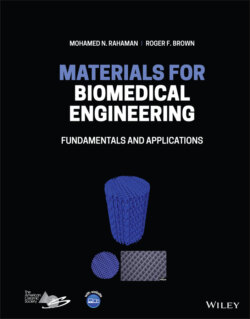Читать книгу Materials for Biomedical Engineering - Mohamed N. Rahaman - Страница 63
2.4.3 Metallic Bonding
ОглавлениеThe metallic bond is the dominant bond in metals and their alloys. Because the metal atoms have low electronegativity, the valence electrons tend to leave the parent atom, making the atom a cation, and form a “sea” of rather free electrons that surrounds the ions (Figure 2.1c). The valence electrons are shared by the cations and are not localized at any one cation. Bonding arises from the strong attraction between the cations and the sea of delocalized electrons. Consequently, the bond has no directionality and the cations arrange themselves to form simple densely packed crystalline structures in solids (Chapter 3). The packing of the cations in the solid can be visualized in a simple manner as the ordered packing of tiny ball bearings.
Except when there is a covalent contribution, as in the high‐melting point metals such as tungsten and tantalum, the metallic bond is somewhat weaker than the ionic or covalent bond. Thus, many metals have a lower strength, lower elastic modulus, and lower melting point than most ceramics (Figure 1.5). The sea of mobile electrons is responsible for the high electrical conductivity of metals and this sea of electrons, together with a greater ability of the cations to undergo thermal vibration, is responsible for their high thermal conductivity. Another attractive property of metals is their ductility, the ability to deform when subjected to sufficiently high mechanical stresses instead of fracturing in a brittle manner, characteristic of ceramics. This ductility is due to the ease with which the metallic bond can be broken and reformed when compared to the ionic or covalent bond, coupled with the ease with which the sea of electrons can adjust itself to accommodate the change in position of the cations (Chapter 3). Metals typically show moderate hardness that is lower than that of most ceramics due to their ability to deform in a ductile manner. Corrosion resistant metals find considerable use as biomaterials in a variety of devices such as fracture fixation plates, implants for total joint repair, and dental implants because of their attractive mechanical properties, and electrodes in pacemakers and neural stimulators because of their high electrical conductivity (Table ).
To summarize at this stage, features of the three types of primary bonds are illustrated in Figure 2.11.
Figure 2.11 Schematic comparison of the attractive interactions in the ionic, covalent, and metallic bond.
